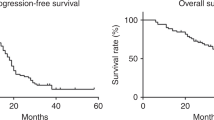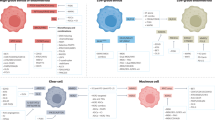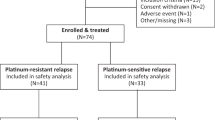Abstract
Fifty-two patients with epithelial ovarian cancer were treated with yttrium-90-labelled monoclonal antibody HMFG1 administered intraperitoneally following conventional surgery and chemotherapy as part of an extended phase I-II trial. The treatment was well tolerated and the only significant toxicity observed was reversible myelosuppression as previously described. Following conventional surgery and chemotherapy, 21 out of the 52 patients had no evidence of residual disease and were regarded as receiving treatment in an adjuvant setting. To date, two of these patients have died of their disease (follow-up 3-62 months, median follow-up 35 months). This extended phase I-II study suggests that patients with advanced ovarian cancer who achieve a complete remission following conventional therapy may benefit from further treatment with intraperitoneal radioactive monoclonal antibody.
This is a preview of subscription content, access via your institution
Access options
Subscribe to this journal
Receive 24 print issues and online access
$259.00 per year
only $10.79 per issue
Buy this article
- Purchase on Springer Link
- Instant access to full article PDF
Prices may be subject to local taxes which are calculated during checkout
Similar content being viewed by others
Author information
Authors and Affiliations
Rights and permissions
About this article
Cite this article
Hird, V., Maraveyas, A., Snook, D. et al. Adjuvant therapy of ovarian cancer with radioactive monoclonal antibody. Br J Cancer 68, 403–406 (1993). https://doi.org/10.1038/bjc.1993.349
Issue Date:
DOI: https://doi.org/10.1038/bjc.1993.349
This article is cited by
-
Label-free in vivo molecular imaging of underglycosylated mucin-1 expression in tumour cells
Nature Communications (2015)
-
Immunotherapy for Ovarian Cancer
Current Treatment Options in Oncology (2015)
-
The role of tumour-associated MUC1 in epithelial ovarian cancer metastasis and progression
Cancer and Metastasis Reviews (2013)
-
Clinical radioimmunotherapy—the role of radiobiology
Nature Reviews Clinical Oncology (2011)
-
Ovarian cancer immunotherapy: opportunities, progresses and challenges
Journal of Hematology & Oncology (2010)



